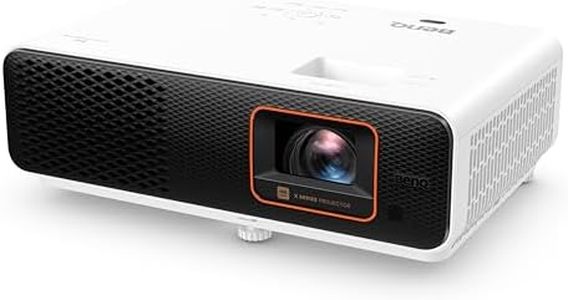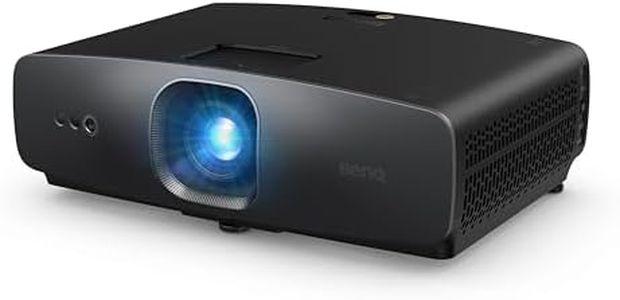We Use CookiesWe use cookies to enhance the security, performance,
functionality and for analytical and promotional activities. By continuing to browse this site you
are agreeing to our privacy policy
10 Best Projectors
From leading brands and best sellers available on the web.By clicking on a link to a third party's website, log data is shared with that third party.
Buying Guide for the Best Projectors
Choosing a projector can really enhance your entertainment, presentations, or gaming experience, but the right model depends on how and where you plan to use it. Start by considering your main use—whether it's for home theater, business presentations, education, or gaming—then match the projector’s features to your needs and location. The environment, like the amount of ambient light and available space, will play a big role in what matters most. Understanding the main specs is key to finding a projector that fits your lifestyle and provides a satisfying viewing experience.Brightness (Lumens)Brightness, measured in lumens, tells you how much light the projector emits and affects how the image looks in different lighting conditions. In dim or dark rooms, lower brightness may be fine, but brighter rooms need higher lumens to keep the image clear and vivid. If your room is dark, projectors under 2,000 lumens often do the job. For rooms with some ambient light, 2,000 to 3,500 lumens offers good flexibility, and for very bright spaces like classrooms or outdoor use, look for models over 3,500 lumens. Think about where you’ll use the projector most and how much control you have over the light to decide what brightness is best for you.
ResolutionResolution is about how many pixels the projector displays, which affects the sharpness and detail of the picture. Common resolutions are SVGA (800x600), XGA (1024x768), HD (1280x720), Full HD (1920x1080), and 4K (3840x2160). Lower resolutions, like SVGA and XGA, work for basic presentations and text, while Full HD and 4K give much sharper images that are great for movies, games, or detailed work. Pick the resolution that matches the type of content you’ll use most—if you want crisp movies or gaming visuals, go higher; for simple slides or data, lower is often enough.
Contrast RatioThe contrast ratio measures the difference between the darkest black and the brightest white the projector can produce. Higher ratios mean better ability to show detail in shadows and highlights, which is great for movies and photos. Ratios can range from 1,500:1 for basic models to over 10,000:1 in more advanced ones. If you love watching films or want deep colors, choose a higher contrast ratio; for basic spreadsheets or text-heavy presentations, this spec is less critical.
Throw Distance and Lens ZoomThrow distance is how far the projector needs to be from the screen to create a certain image size, and lens zoom lets you adjust the image size without moving the projector. Short throw models can make a big image from close up, ideal for small rooms or tight spaces, while standard throw projectors need more room. If you have limited space between your projector and screen, or if you want flexibility in setup, look for short throw and good zoom features. Measure your room and consider where you can place the projector before deciding.
PortabilityProjector size and weight determine how easily you can move it around. Ultra-portable or pocket-sized projectors are great for travel or impromptu presentations, while medium and large models may be better for permanent setups. If you’ll be carrying it between rooms, to classes, or on trips, choose a lighter, compact model; if it’ll stay in one spot, portability matters less and you can focus on other specs.
ConnectivityConnectivity options let you plug in devices like laptops, media players, or gaming consoles. Look for HDMI and USB ports as basics, plus wireless options like Wi-Fi and Bluetooth if you prefer cable-free setup. Some models have built-in screensharing or apps. Consider which devices you want to use and make sure the projector has the right ports and compatibility for your needs.
Lamp LifeLamp life tells how many hours the projector lamp will last before you need to replace it, affecting long-term ownership and convenience. Basic lamps may last around 2,000-3,000 hours, while LED or laser-based projectors often last 20,000 hours or more. If you'll use the projector a lot, longer lamp life means less maintenance.
Built-in AudioBuilt-in speakers in projectors vary in quality and volume, and they can be handy if you don't want to set up separate audio equipment. If stereo sound and clarity matter, like for movie nights, check the wattage of the built-in speakers or be prepared to connect external speakers. For basic presentations, built-in audio can often be enough.






![Projector 4K [Google TV/Dolby Audio] Netflix Disney+ Official,1000 ANSI Auto Focus/Keystone 1080P Portable Projector,Voice Control, WiFi6 Bluetooth HDR10 Smart Movie Home Projector for Bedroom Outdoor](https://images-proxy.bestreviews.guide/CLWRT1xww6yQE3TnOXPYAZe2Be4=/0x300/https://m.media-amazon.com/images/I/51DC3fX1yQL._AC_CX679_.jpg)









